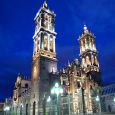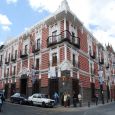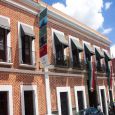Puebla
Advertisement
By air
Puebla is served by Hermanos Serdán International Airport, which is part of the metropolitan airport group for the Mexican capital and an alternate airport for Mexico City. It provides domestic services and flights to the United States. The airport is going under a construction phase to build a new terminal which would be capable of handling many international flights. The airport is also used as a place to manufacture goods and export and import due to prime location.
By road
Traveling to Puebla from Mexico City is fairly straightforward and can be accomplished via bus. There are continual bus services between Mexico City and Puebla throughout the day and night both from the TAPO terminal (also known as Terminal Oriente, located beside the San Lazaro Metro station) and from Benito Juarez International Airport.
A one-way ticket on ADO or Estrella Roja from the TAPO usually runs about $110 pesos (~$9 USD) for regular direct service; a first class ticket ("Pullman Primera Clase" service) on Estrella Roja costs about $130 pesos (~$10.50 USD). (The extra 20 pesos or so are worth it: the first class coaches seat less people, thus less crowded, more space, more comfortable.) Buses leave for Puebla approximately every half hour from both locations. Travel time from TAPO to Puebla's CAPU is usually around 2 hours, but this time may vary by up to a full hour depending on Mexico City traffic conditions at that time of day. Taking an Estrella Roja bus from the airport costs about $170 pesos (~$15USD) for a one-way ticket or $320 pesos (~$25USD) for a roundtrip.
Advertisement
Puebla Cathedral
Puebla Cathedral is a Roman Catholic cathedral in the city of Puebla, in Puebla, Mexico. It is a colonial cathedral, and is the see of the Roman Catholic Archdiocese of Puebla de los Angeles. The cathedral's bishop is Víctor Sánchez Espinosa. The cathedral is dedicated to the Immaculate Conception.On January 24th, 1557 the Viceroy Martín Enríquez (1562-80) designated Juan de Cigorondo, a neighbor of México for worker and Francisco Becerra was appointed architect. The design was submitted to the Dean and Cathedral Chapter on November 11th 1557
Casa del Dean
The Casa del Dean is the oldest noble house in the city of Puebla, constructed by Tomás de la Plaza Goes, who was the deacon of the Cathedral of Puebla. It was finished in 1580. The building remained practically intact until 1953, when it was going to be demolished to construct a movie theater. Protests to save the building, due to its murals and façade, succeeded. The murals are frescos, which are the only surviving non-religious examples from the 16th century in their original place in Mexico. The gray stone facade is completely smooth to let the main portal, of Renaissance style, stand out. The portal contains and upper and lower portion with a crest
Amparo Museum
The Amparo Museum, located in the historic center of Puebla, is one of the most important historical museums in Mexico. It was inaugurated in 1991 and sponsored by the Amparo Foundation, which was founded in 1979 by Manuel Espinoza Yglesias in honor of his wife.The museum is houses in two colonial-era buildings that date from the 17th and 18th centuries, which were popularly known as the Hospitalario. One of the buildings was the Hospital de Nuestra Señora y San Juan de Letrán founded in 1534.
The Museo de Arte
The Museo de Arte (Museum of Art) originally was constructed to be the Temple of San Pedro, founded in 1541 to be a church and a hospital. Eventually it was established as the Hospital of San Pedro y San Pablo under the direction of the Cathedral of Tlaxcala. It was functioning as a hospital by 1544, but it incurred major expenditures, forcing it to limit service to men only. The arches of the main courtyard were completed in 1640, as well as it fountain and nursing units. In the first half of the 18th century, the hospital ceased to be under the direct control of the Cathedral, passing to the monks of the order of San Juan de Dios. In the latter half of the century, it began to house soldiers in order to improve its finances
The Casa de Alfenique
The Casa de Alfeñique is named for the intricate mortar work that covers its facade. Alfeñique is a kind of sugar and almond candy. It was constructed by Antonio Santamaría de Incháurregui for Juan Ignacio Morales, who was a master ironsmith. The facades also contain ironwork balconies, cornices and a crown. The house was left to the state by Alejandro Ruiz Olavarrieta in 1896. It was first used to house the first public museum in the city of Puebla. The collection contains more than 1,500 pieces of a historical nature
Fort Loreto and Fort Guadalupe
Fort Loreto and Fort Guadalupe are located in the Centro Civico 5 de Mayo part of the city. Both were instrumental to the Battle of Puebla on 5 May 1862. The chapel of the Loreto fort contains a former chapel, which is now the Museo de la No Intervención (Museum of Non-Intervention). This is to commemorate a non-aggression pact signed by Mexico and Central American and two South American countries in the 1960s. The Museo de Guerra del Fuerte (Fort War Museum) de Loreto y Guadalupe is located in this fort as well. This museum contains cannons, shotguns, swords, documents and other objects related to this battle
The Municipal Palace
The Municipal Palace is located on Maximino Avila Camacho. The facade is made of gray cantera stone in Renaissance style, using Ionic columns and pediments, differing from the other buildings that border the main plaza. The portal has two levels topped by a central garret, in which there is a clock and towers on each side
Information not available
Information not available
Advertisement








